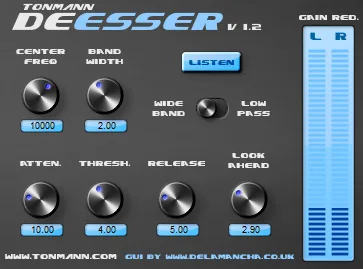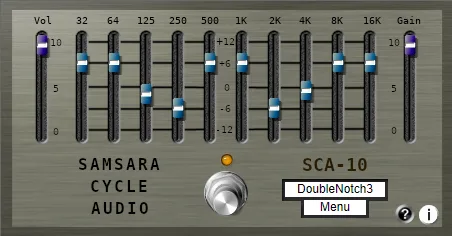Tonmann DeEsser – Clean Vocals Without Sibilance
In the world of sound recording and music mixing, vocals are often the central element of a composition. Their clarity, intelligibility, and emotionality are crucial to the success of a track. However, the vocal processing, especially the use of compression to level out dynamics and high-frequency boosting to add “air” and “presence,” can lead to unpleasant side effects. One of the most common and annoying is the overemphasis of sibilant sounds, or sibilants (which occur when pronouncing the letters “s,” “z,” “sh,” “zh,” and “ts”). These sharp, hissing or whistling sounds can spoil the overall impression, distract the listener, and make the vocals sound unnatural, especially at high volumes.
Unlike other problems, such as plosives (p-sounds), sibilants require a specific approach because they are in a certain frequency band and appear dynamically – only when the corresponding sounds are pronounced. It is precisely to solve this problem that specialized tools exist – DeEssers.
What is Tonmann DeEsser?
Tonmann DeEsser is an effective and easy-to-use dynamic high-frequency processor designed by the German company Tonmann. Its main purpose is the delicate and effective suppression of excessive sibilants on vocal tracks. The philosophy behind the development of Tonmann DeEsser is to create a tool that performs its function as transparently as possible, avoiding the “artificial” artifacts typical of some similar plugins, which can make the vocals sound muffled, lisping, or unnaturally processed. The plugin works by identifying the frequency band where sibilants usually reside and reducing the signal volume in this band only when it exceeds a set threshold. This makes it similar to a “smart” dynamic equalizer or a multi-band compressor focused on a specific problem.
Main advantages and functions of Tonmann DeEsser
- Independent stereo processing: Tonmann DeEsser supports both independent processing of the left and right channels for working with stereo vocals or stereo buses, and the classic mono mode. This provides flexibility in application in various mixing scenarios.
- Reduction modes: The plugin offers two modes of operation: wideband, where the entire signal is muted, and low-frequency reduction mode, which is likely a variation of the split-band mode that affects only the high-frequency part of the spectrum. The mode selection allows you to adapt the plugin to the specific material and the desired result.
- Flexible detection settings: You can precisely define the center frequency and bandwidth that Tonmann DeEsser will analyze for sibilants. Because the frequency of sibilants can vary significantly depending on the vocalist, microphone, and language, this feature is critical for accurate and efficient setup.
- Adjustable threshold: This parameter determines the volume level that the signal in the detection band must exceed for the plugin to start working. Correctly setting the threshold allows you to remove only unwanted, too loud sibilants, while maintaining the natural “airiness” and detail of the vocals.
- “Look Ahead” function: Sibilants often have a very fast and sharp “attack.” The Look Ahead function allows the plugin to “hear” the approach of a sibilant a fraction of a millisecond before it reaches its peak, which allows the plugin to trigger in time and effectively suppress even the sharpest transients without “skipping.”
- Adjustable release time: This parameter controls how quickly the plugin stops muting the signal after the level in the detection band falls below the threshold. Setting the Release time is important to avoid unwanted artifacts, such as “pumping” (when the signal volume fluctuates unnaturally) or “lisping” (when the vocals sound as if the performer is lisping).
- Wide attenuation range: The ability to deeply attenuate (attenuation) allows you to flexibly integrate Tonmann DeEsser into your processing chain. You can use it both before the compressor (for “softer” compression without excessive response to sibilants) and after it (for more targeted correction after dynamic processing).
- “What you remove” listening mode: One of the most useful functions of Tonmann DeEsser. It allows you to listen in isolation to the part of the signal that the plugin removes. This is extremely helpful when setting the frequency, bandwidth, and threshold, allowing you to make sure that you are removing only sibilants and not important vocal overtones or breaths.
- Visual level indication: The plugin is equipped with two level indicators that provide visual control over the input signal level and the degree of muting.
How to use Tonmann DeEsser
The typical place of Tonmann DeEsser in the vocal processing chain is after the equalizer and compressor, as these effects often emphasize sibilants. However, depending on the specific case and the desired sound, it can also be placed before the compressor. Start with a wide detection band and gradually narrow it down, using the “What you remove” mode to find the exact frequency range of the sibilants. Then carefully adjust the threshold and attenuation, again controlling the result in the listening mode of the removed signal, to achieve the desired level of muting without losing naturalness.
Tonmann DeEsser is not just another plugin, but a specialized tool that effectively and naturally solves one of the most common problems of vocal processing. Its well-thought-out set of functions, including the unique listening mode of the removed signal, makes it a valuable addition to the arsenal of both an experienced sound engineer and an amateur musician who wants to achieve a professional sound of their vocals. Try Tonmann DeEsser and see how much cleaner and more pleasant your vocals can become!



